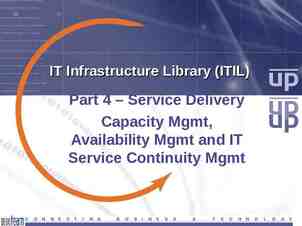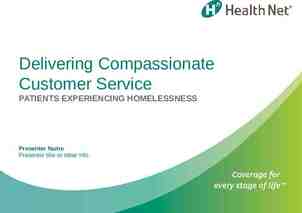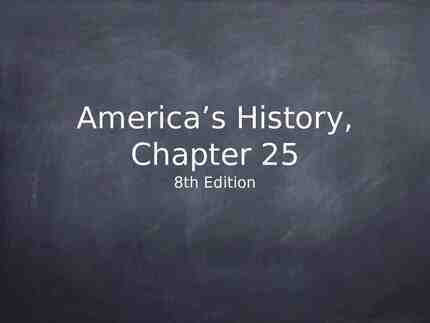2021 Telecommunications Workshop
58 Slides3.46 MB

2021 Telecommunications Workshop

Auxiliary Telecommunications 2021 Telecommunications Workshop Response Directorate 2

Welcome This workshop will: Discuss how Risk Management relates to Communications Highlight policies and procedures in practical Operations Review current communications programs and missions Discuss experiences in Communications and look for improvement This is an optional workshop, but it may be “required” at the local level for all Telecommunications Operators (TCO) 2021 Telecommunications Workshop Response Directorate 3

Ground Rules This workshop is interactive, and should not be a Lecture Ask Questions Answer Questions Share Experiences Share Insights A summary of opinions and feedback should be passed up the Chain of Leadership/Management. Participate – Participate - Participate 2021 Telecommunications Workshop Response Directorate 4

Risk Management 2021 Risk Management Discussion 2021 Telecommunications Workshop Response Directorate 5

What Do You Need to Do? Within Communications, all Elected Officers, Response Directorate, CM officers, TCO and CWS are required to take immediately, and maintain RM/TCT training. Complete the Introduction to Risk Management training course on AUXLMS, course 100202 This is a one-time training requirement to introduce the principals of RM and the critical human factors skills Annually complete TCT refresher class includes RM refresher 2021 Telecommunications Workshop Response Directorate 6

What is Risk Management A continuous, systematic, process of identifying and controlling risk in all activities, according to a set of preconceived parameters, by applying appropriate management policies and procedures. This process includes detecting hazards, assessing risk, and implementing and monitoring risk controls to support effective, risk-based decision-making. 2021 Telecommunications Workshop Response Directorate 7

Risk Management The Risk Management (RM) Instruction includes: A 5 step process The PEACE and STAAR models Risk Assessment Matrix (RAM) Mandates the use of GAR 2.0 Standardizes RM training for all communities (surface, air, shore) 2021 Telecommunications Workshop Response Directorate 8

Risk Management Coast Guard (including Auxiliary) operations are inherently complex, dynamic, potentially dangerous, and, by nature, involve the acceptance of some level of risk Risk Management is more than a form or a process It is a mindset and awareness of risk and reward that can be used not only in your Auxiliary life but in everything that we do 2021 Telecommunications Workshop Response Directorate 9

Risk Management for Communicators As Auxiliary Communicators, how do we use RM? While standing a radio watch, can you help detect hazards, assess risk, and implement and monitor risk controls to support effective, risk-based decision-making? Sure you can, and you probably already do. Remember that you are a member of the same team as those you may be supporting. 2021 Telecommunications Workshop Response Directorate 10

Risk Management As A Way Of Life We continually make decisions based on how much risk we are willing to accept in personal life and in the Auxiliary By increasing our understanding of Risk and Risk Management, we will increase our performance and safety 2021 Telecommunications Workshop Response Directorate 11

Risk Management As A Way Of Life We Take Steps To Mitigate The Risks – Ask for Help – Modify Our Plans Change Our Start Time Change Our Route – Check Our Equipment 2021 Telecommunications Workshop Response Directorate 12

Providing First Aid - CPR From AUXILIARY OPERATIONS POLICY MANUAL COMDTINST M16798.3E: E.10. Emergency Medical Response First aid training (beyond a basic awareness of emergency situations) is not a part of the Auxiliary boat or air crew qualification process. Auxiliarists, while on orders (verbal or written) or while assigned to duty, can give first aid. In cases of boating emergencies, Auxiliarists shall advise the unit commander of any emergency medical situation. If unable to contact the unit commander, then seek guidance from competent medical authority. NOTE The Auxiliarist may only provide first aid that they are trained to give and which is within the scope of their assigned duties. For example, an Auxiliarist on an authorized patrol who is not CPR, qualified must not perform CPR but an Auxiliarist who is CPR qualified may. 2021 Telecommunications Workshop Response Directorate 13

Mishap Reporting ALL mishaps must be reported to the Order Issuing Authority (OIA) immediately A Coast Guard mishap is defined as any unplanned, unexpected or undesirable event that causes injury, occupational illness, death, material loss or damage. The Auxiliary wants any incident which causes a disruption or alteration of the mission reported. This allows the mishap to become an education opportunity to be shared across the entire organization. Mishap reporting does not equal disciplinary action This does not apply for flagrant disregard of the rules or reckless or foolhardy actions. Incidents occur Not reporting a mishap may lead to disciplinary action 2021 Telecommunications Workshop Response Directorate 14

Policies & Procedures 2021 Policy and Procedures Overview 2021 Telecommunications Workshop Response Directorate 15

Communications Governance AUX Operations Policy Manual (COMDTINST M16798.3 Series) Telecommunications Manual (COMDTINST M2000.3 Series) Radio Telephone Handbook – Tactics, Techniques, and Procedures (CGTTP 6-01.1 Series) Auxiliary Communications Program, Standard Operating Procedure, 21 March 2016 2020 Telecommunications Workshop Response Directorate

Concept Of Operations CONCEPT OF OPERATIONS – CONOPS – Auxiliary Communications Program – Standard Operating Procedures released on 21 March 2016, provides a foundation for the growth and development of current Auxiliary communications capabilities - while conveying to the US Coast Guard Auxiliary (CGAUX) and the US Coast Guard (CG), the role, assets, activities, operations, and overall policies of the Auxiliary Communication System (ACS) Communication officers at all levels, are responsible for maintaining an accurate radio communications resource availability list. (See: ICS Form 217A CG) – ACP-SOP and many other helpful forms may be found on the National Auxiliary website. Go to Directorates, select Response from the top pull down menu. Then on the left side of the screen select Regs & Procedures, then Telecommunications Docs. 2021 Telecommunications Workshop Response Directorate

Authorized Operation of Radio Facilities – Auxiliarists may offer their radios to be used as Auxiliary facilities. If accepted, a single facility identification for all radios at the facility (HF and VHF) used in the same service* will be assigned by DIRAUX or keyed from AUXDATA with DIRAUX approval – DIRAUX must approve facilities and VHF callsigns which may be assigned by District CM Staff The DVC-RT issues all HF callsigns * - a repeater or transportable station is an example of a different service from general fixed land VHF and HF 2020 Telecommunications Workshop Response Directorate

Authorized Operation of Radio Facilities (Cont.) In order to “Offer for Use“ your radio equipment as an Auxiliary Radio Facility or to seek orders as an Auxiliary Radio Operator you must be a “Qualified Auxiliarist”. You must have Telecommunications Operator (TCO) Qualification and have all currency maintained. Having AUXCOM prior to 2008-08-01 is acceptable but TCO is recommended. 2021 Telecommunications Workshop Response Directorate 19

Authorized Operation of Radio Facilities (Cont.) Only Auxiliary communications staff, elected officers or an OIA may activate Auxiliary radio facilities under one or more of the following conditions: (Discuss how each of these could pertain to your AOR?) For a mission ordered or scheduled by the Coast Guard When necessary to handle valid distress traffic While conducting technical tests to determine a facility’s capability (e.g., facility inspection) 2021 Telecommunications Workshop Response Directorate 20

Authorized Operation of Radio Facilities (Cont.) When necessary to contact a Coast Guard unit to determine if Auxiliary help is required When conducting net drills For assisting in time of disasters or national emergencies When necessary to conduct authorized Auxiliary activities as assigned by appropriate Coast Guard unit, Auxiliary Operational Commanders or Staff officers Reference: Operations Policy Manual, Annex 4.C.4 2021 Telecommunications Workshop Response Directorate 21

Radio Basics In all radio communications, we are to act as professionals At no time shall we refer to ethnicity, race, gender, sexual orientation or religious affiliation in radio transmissions This is a zero-tolerance policy and must be strictly adhered to 2021 Telecommunications Workshop Response Directorate 22

Radio Basics (Cont.) It is often not what you say, but how you say it that demonstrates your professionalism Brevity and accuracy support mission success and safety Remember, the public and other agencies “hear” you as the voice of the U.S. Coast Guard Practice and use proper radio procedures to achieve success, safety, and professionalism – (No “10” codes, no “Over and Out”, no “Roger WILCO”, etc.) 2021 Telecommunications Workshop Response Directorate 23

Radio Basics (Cont.) REMEMBER: Always listen before transmitting and be sure you are on the correct channel (frequency) and no one else is talking Professional presentation – Voice of the Coast Guard Speak slowly, clearly and calmly– Must be understood the first time Use proper PROWORDS, avoid slang and jargon 2021 Telecommunications Workshop Response Directorate 24

Marine Channel 16 Channel 16 is the international emergency/distress and calling channel Monitor channel 16 whenever able (at least in scan mode) even if there is a specific reason to monitor another channel (regatta, SAR case, guard channel, etc.) Encourage all boaters to monitor channel 16 when underway 2021 Telecommunications Workshop Response Directorate 25

Programs & Missions 2021 Communications Programs & Missions 2021 Telecommunications Workshop Response Directorate 26

Who is in charge? 2021 Telecommunications Workshop Response Directorate 27

Communications Operations VHF Radio Guard for AUX Vessels and Aircraft Watch Standing at Coast Guard Stations and Facilities HF Programs – HF Contingency Nets – HF Monitoring (AUXMON) – Communications Augmentation (AUGCOM) – SHARES Rescue 21 Contingency Support District and Sector Activities AUXSCOUT Program AUX VHF Narrowband Operations – Our own space – used for? 2020 Telecommunications Workshop Response Directorate

VHF Communications 7 CG Auxiliary narrow band VHF frequencies are available for our use on narrow band radios with maximum allowed output power of 50 watts. (AUXNET) Work is being done to standardize these nationally. – – – – Administrative support Command and Control Repeater – wide-area Auxiliary coordination Training VHF repeaters are allowed an output power of 100 watts Maximum output power on channels in the “Marine band” is 25 watts No power amplifiers allowed on VHF radios 2021 Telecommunications Workshop Response Directorate 29

VHF Communications (Cont.) RDF (Radio Direction Finding) stations are authorized VHF handheld marine radios MAY be accepted as mobile facilities in special cases APRS (Automatic Packet Reporting System) is not authorized MMSI (Maritime Mobile Service Identity) numbers are not authorized for Auxiliary aircraft, but can be registered to surface facilities. 2021 Telecommunications Workshop Response Directorate 30

VHF Repeaters There are 56 Auxiliary VHF repeaters currently throughout the United States, most of which share common input/output frequencies, with varied CTCSS tone access. Most are unit owned. A national plan, for uniformity and interoperability across Districts is in its final phase. Repeater requests (CG Form 6086) must be reviewed by CG Office of Spectrum Management before construction or implementation Maximum output power of 100 watts Narrowband only 7 possible frequencies 2021 Telecommunications Workshop Response Directorate 31

CG Station Radio Watchstanding Auxiliary Watchstanders at a CG station must complete the same training as active-duty CG watchstanders and stand a “board examination” – They must have received, or applied for, DO security clearance prior to being certified as a CG Watchstander – Watchstanders serve at the Station CO’s discretion AUXCOM or TCO/PQS are helpful and might be required at the discretion of the station CO/OIC 2021 Telecommunications Workshop Response Directorate 32

Coast Guard Watch Standing The US Coast Guard has asked for Auxiliary members to become Coast Guard Communications Watchstanders (CWS). What does a CG CWS do? Common activities include: Monitor and answer the radios and phones Stand Guard for underway unit assets Keep radio logs and document SAR cases Give unit “Pipes” Assist and keep informed the unit command structure And more 2021 Telecommunications Workshop Response Directorate 33

Watch Standing Requirements Requirements: BQ qualified Passed TCO or AUXCOM prior to 8/1/2008 (varies per District) Current with AUXMT Taken ICS 100, 200, 700, 800 DO Security clearance for CG Watchstander position Next steps: Request approval through FSO-CM to your FC CM/FC requests approval through Auxiliary Coordinator 2021 Telecommunications Workshop Response Directorate 34

Watch Standing Recruitment You are interested in becoming a CWS and helping a CG Unit. What do you do? 2021 Telecommunications Workshop Response Directorate 35

Auxiliary Station Watchstander Watchstanders at an Auxiliary Communications unit (ACU) must be certified as TCO or completed AUXCOM prior to August 1, 2008 – Must be TCO certified if the chief operator in a multipleoperator situation. Other operators must be under the supervision of the TCO. – Other requirements might be required, on a District-by-District basis – A radio watch requires that the station is actively manned, and the operator is ready for intervention 2021 Telecommunications Workshop Response Directorate 36

Vessel & Aircraft Guard Auxiliary Communications Units (ACUs) may be authorized by CG OIA to provide radio guard for AUX vessels and aircraft – ACUs may provide guard CG vessels when directed by an OIA. All AUX vessels and aircraft must maintain a radio guard with a land station or other designated AUX communications facility. Vessels under 60 feet – Every 30 minutes * Fixed wing, multi-engine aircraft – Every 30 minutes* Single-engine fixed wing and rotary wing aircraft – Every 15 minutes* Must report status of operations and present geographic location (aircraft may also report fuel status every 30 min) *unless otherwise assigned by the command 2021 Telecommunications Workshop Response Directorate 37

Holding Guard When assuming “Guard”, you have taken responsibility for continuous monitoring of the vessel, aircraft or activity Communications schedules with the unit must be maintained If schedules are missed, a sequence of steps must be initiated to re-establish comms and determine condition of the monitored unit OIAs must be notified when comms are lost for a predetermined period 2021 Telecommunications Workshop Response Directorate 38

HF Communications HF serves as a platform for several missions: – HF Voice and Data Contingency Nets – AUXMON (Auxiliary Monitoring Mission) A quality control program for Coast Guard broadcasts – AUGCOM GMDSS monitoring for digital and SSB voice distress calls (replaces the old SSB voice distress calls) – SHARES – A DHS administered radio program coordinating a voluntary network of government, industry, and disaster response agency HF radio stations used for emergency communications 2021 Telecommunications Workshop Response Directorate 39

HF Communications – Radio Facilities – Maximum power output 1000 watts on HF radios – Usable for Auxiliary HF radio Nets – 41 frequencies 2-23 MHz are available – Radios must be able to transmit outside of Amateur bands – Accommodates digital modes – Supports CG contingencies and SHARES Radios must meet NTIA (National Telecommunications & Information Administration) standards 2021 Telecommunications Workshop Response Directorate 40

HF Contingency Nets Many districts have established contingency nets of HF stations. Contingency nets are requested by districts or regions and coordinated through BC-RTC for approval by DVC-RT in coordination with COMMCOM (CG Communications Command) All nets provide contingency voice communications Many nets have capability to send digital message traffic Nets work closely with SHARES for regional operations Most nets practice on a schedule Net may be activated by DSO-CM on direction from the district or DCO 2021 Telecommunications Workshop Response Directorate 41

AUXMON AUXMON stations monitor CG broadcasts to mariners on stations located on the East Coast, Gulf Coast and Pacific Coast The Coast Guard broadcasts are by HF voice, digital, and FAX Members monitor and report any problems to COMMCOM HF radio equipment and special software is required to participate in the AUXMON program Additional AUXMON members are needed For application, please see: http://rdept.cgaux.org/documents/Comms/AUXMONApplicationrs.pdf 2021 Telecommunications Workshop Response Directorate 42

AUGCOM MISSION Directly supports the CG COMMCOM, Sectors and other CG Commands Provide active and passive monitoring of HF voice and DSC message traffic when potential outages of Coast Guard COMSTAs could occur. Aids response to GMDSS HF maritime services for sea area A-2 Participants are a select group of qualified Auxiliary HF facilities and designated as AUGCOMSTA Requires marine sideband equipment and software to monitor DSC messages. Activated on specific orders from COMMCOM through National Telecomm Staff 2021 Telecommunications Workshop Response Directorate 43

SHARES (Shared Resources) Administered by Department of Homeland Security (DHS) This program provides the Federal emergency response community with a single interagency emergency message handling and frequency spectrum management system SHARES promotes interoperability between HF radio systems used by Federal departments and agencies and monitors applicable regulatory, procedural, and technical issues Auxiliary stations may be part of the SHARES network. Check the information on the Telecommunications National Web site 2021 Telecommunications Workshop Response Directorate 44

Rescue 21 Contingency Support Rescue 21 is the computer-based search and rescue and command and control system used by the Coast Guard active-duty stations Rescue 21 is highly reliable but may suffer outages if the remote facilities are damaged or out of service The Auxiliary has partnered with Coast Guard commands to provide contingency coverage for Rescue 21 outages (varies by district and sector) 2020 Telecommunications Workshop Response Directorate 45

Rescue 21 Contingency (cont.) CG OIAs activate selected Auxiliary fixed and transportable facilities to cover gaps in coverage during R21 outages AUX stations provide nominal monitoring out to 15 or more nautical miles where practical Activated ACUs hearing distress or urgency traffic without CG response report traffic to designated SAR controller. Receiving Auxiliary units respond only upon direction of the CG command 2021 Telecommunications Workshop Response Directorate 46

AUXSCOUT Auxiliary-Sea Scout Youth Development Program When involved with Sea Scouts observe all provisions of the current SOP 2021 Telecommunications Workshop Response Directorate 47

Auxiliary Radio Facilities 2021 Communications Facility Descriptions and Requirements 2021 Telecommunications Workshop Response Directorate 48

What Is A Facility? DIRAUX assigns each asset, whether a vessel, aircraft or radio, a facility identification number (OPFAC #) or Facility Record Number. (e.g., NF81AA, or F-xxxxx if assigned by AUXDATA) The identification number is for record keeping only and is not a call sign. The facility identification/record number must be entered when required in AUXDATA forms 2021 Telecommunications Workshop Response Directorate 49

What Is A Facility? (Cont.) DIRAUX approves VHF radio callsigns, which may be assigned by DIRAUX or the District CM Staff – E.g., “Auxiliary Boston Radio”, where Boston signifies the geographic location. – DIRAUX does not issue Auxiliary HF callsigns HF facility owners must check the HF/MF-SSB box and enter the HF radio information into AUXDATA II for submission to the BC-RTI and DVC-RT for issuance of their HF callsign 2021 Telecommunications Workshop Response Directorate 50

Fixed Land Facilities Fixed land facilities are permanently located in an Auxiliary Communications Unit (ACU) either owned by the Auxiliary or in the residence or similar building, owned by the radio facility Auxiliary owner The location is FIXED and DIRAUX must authorize relocation of the radio facility via Form 7004 2021 Telecommunications Workshop Response Directorate 51

Mobile Radio Facilities Mobile radio facilities are usually mounted in vehicles and can be used while the vehicle is in motion Movement at the direction of the CG requires orders, usually via the AUXDATA II process They are not to be confused with TRANSPORTABLE radio facilities 2021 Telecommunications Workshop Response Directorate 52

What Is A Transportable Facility? A station which is transferred to various fixed locations but is not intended to be used while in motion Examples: Go-kit Trailer Boxed radio with accessories 2021 Telecommunications Workshop Response Directorate 53

Transportable (Cont.) A transportable station is normally configured to permit it to be easily transported and set up for operation in various temporary locations A transportable station should always be ready for emergency deployment, but is not used on a regular basis and is not used at a permanent location Movement at the direction of the CG requires orders via the AUXDATA II process 2021 Telecommunications Workshop Response Directorate 54

OIA Considerations When a Mobile Radio Facility is directed to move, orders are required. The Coast Guard OIA (order issuing authority) approves AUXDATA II orders. When a Transportable Radio Facility is directed to move DIRAUX approval is required – In those situations where an operator (TCO), under orders, travels from home to arrive at a Fixed Land ACU, they are not eligible for travel reimbursement. Depending on their ACU duty hours, relative to mealtime, they may request reimbursement for meals through the AUXDATA II process 2021 Telecommunications Workshop Response Directorate 56

National Contact Information Chief, Telecommunication Division COMO David Elliot, DVC-RT [email protected] 772-781-5969 Program Integration Don Wellons BC-RTI [email protected] 912-266-4041 Contingency Communications David Rockwell, BC-RTC [email protected] 727-823-7580 Coast Guard Support Andy Ely BC-RTS [email protected] 732-390-9300 2021 Telecommunications Workshop Response Directorate 57

References For additional information on Telecommunications please check the references available on the National Web Site Telecommunications area Some documents contain PII or sensitive information and require a password that may be obtained from your DSOCM AUXMON Methods & Procedures AUXMON Methods & Procedures Annex 1 AUXMON Station Application AUXMON 7030 Mission Report Format Auxiliary Radio Net Schedules HF Frequencies HF Registry HF Contingency Net Plan Document Repeater Registry AUXMON Registry (PDF) Auxiliary VHF Frequencies 2020 Telecommunications Workshop Response Directorate 58

Bravo Zulu! Thank you for your participation! We seek your feedback on the content of this presentation. Send your comments to: Division Chief – Education Division Roy Savoca, DIR-R Michelle Thornton, DIR-Rd David Elliot, DVC-RT Bruce Pugh, DVC-RE 2021 Telecommunications Workshop Response Directorate 59






